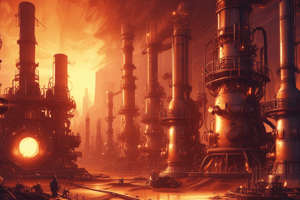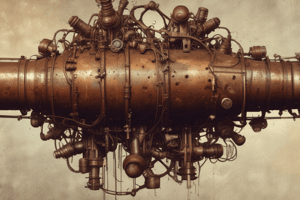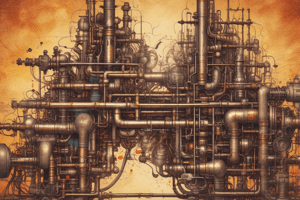Podcast
Questions and Answers
What ions does iron lose when it forms a +3 oxidation state?
What ions does iron lose when it forms a +3 oxidation state?
- 1 electron from both 4s and 3d
- 2 electrons from 4s and 1 electron from 3d (correct)
- 2 electrons from 4s only
- 1 electron from 4s and 2 electrons from 3d
What is the product of the reaction between red hot iron and chlorine?
What is the product of the reaction between red hot iron and chlorine?
- FeCl2
- FeCl3 (correct)
- FeCl4
- FeCl
Which of the following statements about iron's reaction with acids is correct?
Which of the following statements about iron's reaction with acids is correct?
- Iron replaces hydrogen in dilute acids forming iron(II) salts. (correct)
- Iron does not react with dilute acids.
- Iron forms hydrogen gas without producing any salts.
- Iron replaces hydrogen and forms iron(III) salts.
Why does iron sometimes produce iron(II) and other times iron(III) in its reactions?
Why does iron sometimes produce iron(II) and other times iron(III) in its reactions?
What is the reaction between red hot iron and steam producing?
What is the reaction between red hot iron and steam producing?
What is a primary factor in the production of steel?
What is a primary factor in the production of steel?
Which of the following furnaces is NOT typically used in steel production?
Which of the following furnaces is NOT typically used in steel production?
What is an alloy?
What is an alloy?
Which of the following elements might be added to steel to enhance its properties?
Which of the following elements might be added to steel to enhance its properties?
What is the role of oxygen in steel production?
What is the role of oxygen in steel production?
Which two elements are specifically mentioned as having magnetic properties?
Which two elements are specifically mentioned as having magnetic properties?
What does the magnetic moment of an element indicate?
What does the magnetic moment of an element indicate?
How is the magnetic moment of an element determined?
How is the magnetic moment of an element determined?
Which statement about unpaired electrons is correct?
Which statement about unpaired electrons is correct?
Which of the following elements is least likely to have a significant magnetic moment?
Which of the following elements is least likely to have a significant magnetic moment?
What is the preferred oxidation state of iron due to its half-filled 3d state?
What is the preferred oxidation state of iron due to its half-filled 3d state?
What product is formed when iron reacts with concentrated sulfuric acid?
What product is formed when iron reacts with concentrated sulfuric acid?
What prevents the further oxidation of ferrous ions to ferric ions?
What prevents the further oxidation of ferrous ions to ferric ions?
In which reaction condition is FeCl3 produced?
In which reaction condition is FeCl3 produced?
What is not a product of the reaction between iron and concentrated sulfuric acid?
What is not a product of the reaction between iron and concentrated sulfuric acid?
What happens to two magnetic fields that are oriented in opposite directions?
What happens to two magnetic fields that are oriented in opposite directions?
Why do transition metals have an increased number of oxidation states in the middle of their group?
Why do transition metals have an increased number of oxidation states in the middle of their group?
Which characteristic is typically associated with the oxidation states of transition metals?
Which characteristic is typically associated with the oxidation states of transition metals?
What role do d orbitals play in the oxidation states of transition metals?
What role do d orbitals play in the oxidation states of transition metals?
In the context of transition metals, what is a key reason for the increased complexity of oxidation states?
In the context of transition metals, what is a key reason for the increased complexity of oxidation states?
Flashcards are hidden until you start studying
Study Notes
Iron's Oxidation States
- Iron can exist in two common oxidation states: +2 (ferrous) and +3 (ferric).
- Iron prefers the +3 state due to having a half-filled 3d orbital, which is more stable.
- However, reaction conditions or products can prevent further oxidation to +3, resulting in the formation of ferrous compounds.
Iron's Reactions
- Dry Air: Red-hot iron reacts with oxygen to form iron(II,III) oxide (Fe3O4).
- Water Vapor: Red-hot iron reacts with water vapor to produce iron(II,III) oxide (Fe3O4) and hydrogen gas.
- Non-metals:
- Hot iron reacts with chlorine to produce iron(III) chloride (FeCl3) – chlorine is a stronger oxidizing agent than sulfur.
- Iron reacts with sulfur to produce iron(II) sulfide (FeS).
- Acids:
- Dilute Acids: Iron is more active than hydrogen, thus replacing it in dilute acids to form ferrous salts and hydrogen gas.
- Examples:
- Fe + H2SO4 (dil) -> FeSO4 + H2
- Fe + 2HCl (dil) -> FeCl2 + H2
- Examples:
- Concentrated Acids:
- With concentrated sulfuric acid, iron produces a mixture of ferrous and ferric sulfates, sulfur dioxide, and water.
- 3Fe + 8H2SO4 (conc) -> FeSO4 + Fe2(SO4)3 + 4SO2 + 8H2O
- Iron does not react with concentrated nitric acid – its passivation due to the formation of a protective oxide layer.
- With concentrated sulfuric acid, iron produces a mixture of ferrous and ferric sulfates, sulfur dioxide, and water.
- Dilute Acids: Iron is more active than hydrogen, thus replacing it in dilute acids to form ferrous salts and hydrogen gas.
Why does the number of oxidation states for transition metals increase in the middle of the group?
- Scandium (Sc) and Zinc (Zn) have only one oxidation state due to their fully-filled or empty d-orbitals, respectively.
- Transition metals in the middle have partially filled d-orbitals, allowing for multiple oxidation states.
Magnetic Moment
- Represents the tendency of an element to be attracted to a magnetic field.
- Determined by unpaired electrons in the 3d level.
Steel Production
- Steel production involves two key steps:
- Removing residual impurities from iron.
- Adding specific elements for desired properties.
- Furnaces used for steel production:
- Oxygen converter
- Open-hearth furnace
- Electric furnace
Alloys
- An alloy is a combination of metals (and sometimes non-metals) to achieve superior properties.
Studying That Suits You
Use AI to generate personalized quizzes and flashcards to suit your learning preferences.




